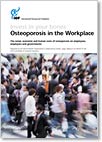Osteoporosis in the workplace
The social, economic and human costs of osteoporosis on employees,employers and governments
Professor Jean-Yves Reginster, director of the WHO Collaborating Center in Liege, Belgium and IOF general secretary, cautions that the calculations of direct costs are preliminary. "Much more research is needed," he said. "Also, we should remember that osteoporosis also results in huge indirect costs that are rarely calculated and which are probably at least 20% of the direct costs. For example, a worker with osteoporosis might lose her or his job, incur medical expenses that are never calculated by economists, and suffer other economic losses. And of course the human suffering, described in the report's case histories, is immense but economically incalculable."
Compiled and written by Florent Richy, University of Liege, Belgium, the report notes:
- Just one in two vertebral fractures is diagnosed by a physician.
- Less than 10-20% of all osteoporosis patients receive timely treatment.
- Vertebral fractures are more serious as a workplace problem than are hip fractures because they are more likely to afflict younger people, even around the age of 50 or earlier.
- The worldwide cost burden of osteoporosis (for all ages) is forecast to increase to $131.5 billion by 2050.
Specific recommendations are given for the individual, the physician, other healthcare professionals, researchers, and the public health sector.
It is time to recognise that osteoporosis does not only affect the elderly.Osteoporosis affects people at various stages of life, including millions of people who are actively working. These people have been ignored in most studies, but the preliminary calculations in this publication show that osteoporosis in the workplace results in huge economic and human costs.This report estimates that the annual direct costs of treating osteoporosis fractures of people in the workplace in the USA, Canada and Europe alone is approximately $48 billion. This cost, of course, does not include the indirect economic costs and the huge emotional price that has to be paid by someone who has broken a vertebra or hip.
Women and men are staying longer in the workplace. In many parts of the world people have no health insurance or compensation for loss of income due to their disability. Also, many health insurance chemes will not cover diagnosis and treatment prior to the first fracture.
This report includes useful recommendations on what should be done to reduce the burden of osteoporosis in the workplace. It also stresses that additional research is required. We urge everyone concerned to take immediate steps to reduce the impact of the "silent epidemic".
 | Download pdf |
